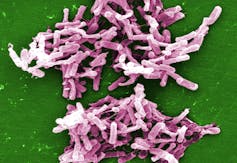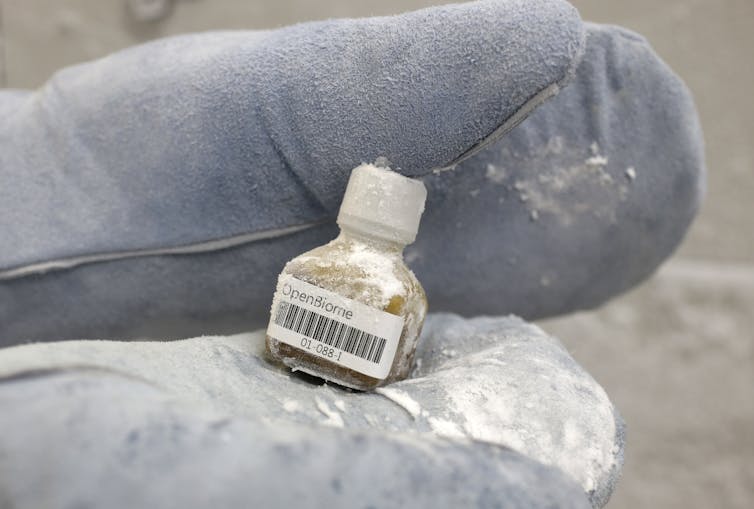A novel 'smart' antibiotic may target most common bacterial infection contracted in US hospitals
- Written by David B. Stewart, Associate Professor of Surgery, University of Arizona
The most common microbe you are likely to pick up during a hospital stay[1] in the United States is Clostridium difficile. This pathogen secretes toxins that trigger diarrhea and colitis, sickening 500,000 patients annually[2]. It kills[3] approximately 29,000 people each year. All this sickness and death comes at a yearly cost to the U.S. health care system of approximately US$6 billion[4]. Ironically, it is the exposure to antibiotics that dramatically increases a person’s risk of developing a C. difficile infection (CDI).
There are several reasons for this paradox. The current antibiotics used in clinical practice kill many beneficial bacteria in the gut as well as the pathogenic target organism. This loss of good microbes causes an unhealthy shift in the bacterial population in the gut that is referred to as dysbiosis[5]. After the beneficial bacteria are wiped out, C. difficile occupies the void left behind.
Treating CDI with conventional antibiotics may in some cases make the situation worse[6]. In a sense, the antibiotics we currently use to treat CDI patients are the same drugs that initially created the ideal conditions in the gut for this pathogenic microbe to flourish and cause infection. This helps explain why these infections persist and recur[7] in between 15 and 30 percent of patients after their first antibiotic regimen.
 This 2004 electron microscope image shows a cluster of Clostridium difficile bacteria. The intestinal bug sickens almost 30,000 Americans each year. C. difficile flourishes in the gut after antibiotics kill off other bacteria and causes diarrhea.
AP Photo/CDC, Lois S. Wiggs, Janice Carr[8]
This 2004 electron microscope image shows a cluster of Clostridium difficile bacteria. The intestinal bug sickens almost 30,000 Americans each year. C. difficile flourishes in the gut after antibiotics kill off other bacteria and causes diarrhea.
AP Photo/CDC, Lois S. Wiggs, Janice Carr[8]
Our team is focused on addressing these clinical treatment gaps for CDI by developing a new kind of antibiotic that does not disturb the beneficial microbes of the gut the way that conventional antibiotics do. To do this, our team is developing drugs that are inexpensive to produce and which are easily modifiable, so that the work we do on C. difficile can be potentially applied to other bacteria.
Our[9] team[10] is developing new targeted antibiotics that only kill C. difficile. We previously published the first paper[11] on using specially designed slivers of DNA to fight CDI. Our most recent publication[12] provides further proof of concept that these pieces of DNA are able to silence genes that are vital for this microbe to survive.
A new weapon
Much of the monetary cost of CDI is driven by the persistent infections and high recurrence rates, which require multiple rounds of antibiotics and longer hospital stays. C. difficile is unique among the bacterial infections affecting humans because it thrives when the gut is in disarray after antibiotic treatment.
Recently, fecal microbiota transplantations (FMT) – microbes collected from the feces of people with healthy guts – have been shown to be be an effective therapy for recurrent CDI[13]. However, safety and efficacy for its use among inpatients with life-threatening CDI, issues regarding reimbursement from insurance companies, and social awkwardness surrounding the medicinal use of human stool currently limit FMT.
We have developed a completely new type of drug that uses small pieces of DNA to disable critical genes in this microbe. Our work has demonstrated that our custom DNA pieces – which we call antisense oligonuceotides (ASOs) – can potentially treat CDI and avoid the pitfalls of traditional therapies. Our DNA drug targets C. difficile based upon unique elements of its genome. Using genetic targets helps to ensure that we only kill one type of bacteria.
Delivering the drug
To design these new antisense DNA drugs[14] we first had to sequence the genome of C. difficile – the entire complement of DNA that encodes the instructions for this bacterium. We then compared its genetic blueprint with that of other microbes and designed ASOs that only match the messages – messenger RNA – generated by important C. difficile genes.
But designing these new ASOs isn’t the only challenge; we still need to get them inside C. difficile. To do that, we also designed special molecules (nanocarriers) which deliver our ASOs into C. difficile without harming the cells lining the colon and without disturbing the community of bacteria that make up the gut microbiome. These transporters essentially taxi our ASOs to their destination, which is why we gave them the acronym CABS for cationic amphiphilic bola-amphiphiles.
In our most recent publication[15], we show that one of our CABS could deliver a dose of ASO to block the growth of C. difficile in culture in the lab. We also demonstrated that our new drug performed comparably to the most frequently used conventional antibiotics. And, when used at doses effective against C. difficile, our drugs left other frequently encountered bacteria largely undisturbed in culture.
 A technical assistant wears protective gloves while displaying a vial containing human fecal solution, frozen to minus 80 degrees Celsius. With many patients no longer responding to potent antibiotics, fecal transplants have proved surprisingly effective treatment for hard-to-treat gut infections.
AP Photo/ Steven Senne[16]
A technical assistant wears protective gloves while displaying a vial containing human fecal solution, frozen to minus 80 degrees Celsius. With many patients no longer responding to potent antibiotics, fecal transplants have proved surprisingly effective treatment for hard-to-treat gut infections.
AP Photo/ Steven Senne[16]
Curbing antimicrobial resistance
Since ASOs are extremely inexpensive, creating a new microbe-specific ASO is a relatively simple drug modification – and an approach that may help stem the growing problem of antimicrobial resistance. Another benefit of our approach is that we can use ASO to target more than one genetic target, which reduces the chance of drug resistance. Our approach also enables us to target bacterial functions that conventional antibiotics could never reach.
For example, C. difficile is able to form spores, making it tougher to kill, and allowing it to survive on surfaces in hospital rooms. Targeting the spore forming genes with our new drugs could disrupt this process, making the organism easier to destroy. C. difficile also produces toxins responsible for the symptoms of colitis (diarrhea, pain, sepsis). Targeting the genes that are responsible for these toxins can reduce the severity of the symptoms and prevent life-threatening forms of this infection.
 C. difficile causes a deadly diarrhea. This graphic describes how and where it spreads and the toll it takes.
cdc.gov[17]
C. difficile causes a deadly diarrhea. This graphic describes how and where it spreads and the toll it takes.
cdc.gov[17]
While our ASOs are designed to be specific to C. difficile, our nanocarriers are not and can be mass-produced to carry ASOs targeting any bacteria. The low cost and wide adaptability of our drug and carrier technology means it could be an especially valuable tool for improving care in impoverished countries where large numbers of people continue to die from diarrheal illnesses from a range of different bacteria.
One unique feature of CDI is that since it affects the colon, these drugs can be delivered via enema directly into the affected organ. This bypasses the rest of the gut, and it may improve efficacy while allowing for a lower drug dose.
Challenges and next steps
We are well aware that we have many steps to go before we can deliver this medicine to humans. One of our first challenges is designing new nanocarriers that can carry larger doses of ASO while having minimal to no effect on the colon or colonic bacteria.
Another challenge is that bacteria often have redundant genes – so targeting the activity of just a single gene may not be enough to kill the microbe or block disease.
If we can successfully develop these drugs, not only would it provide a new treatment for a common infection, but just as importantly, it would introduce an inexpensive and adaptable strategy for developing similar antisense antibiotics for other bacteria.
References
- ^ most common microbe you are likely to pick up during a hospital stay (doi.org)
- ^ 500,000 patients annually (doi.org)
- ^ kills (www.cdc.gov)
- ^ US$6 billion (doi.org)
- ^ dysbiosis (doi.org)
- ^ make the situation worse (doi.org)
- ^ persist and recur (academic.oup.com)
- ^ AP Photo/CDC, Lois S. Wiggs, Janice Carr (www.apimages.com)
- ^ Our (cancer.psu.edu)
- ^ team (surgery.arizona.edu)
- ^ paper (doi.org)
- ^ publication (doi.org)
- ^ recurrent CDI (doi.org)
- ^ new antisense DNA drugs (doi.org)
- ^ publication (doi.org)
- ^ AP Photo/ Steven Senne (www.apimages.com)
- ^ cdc.gov (www.cdc.gov)
Authors: David B. Stewart, Associate Professor of Surgery, University of Arizona

